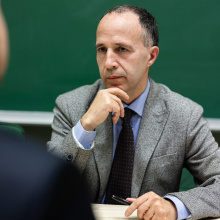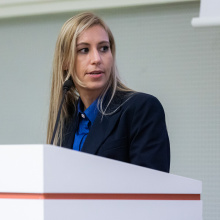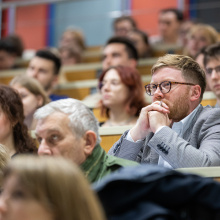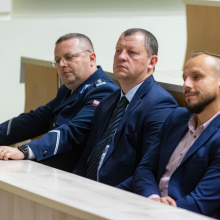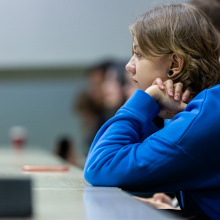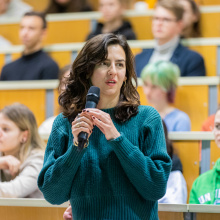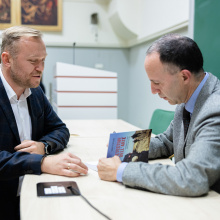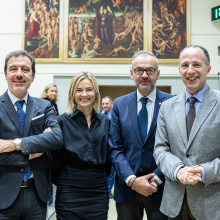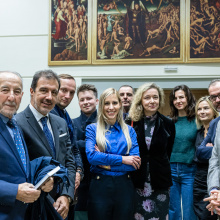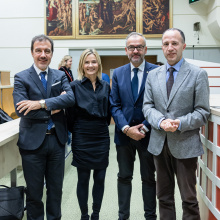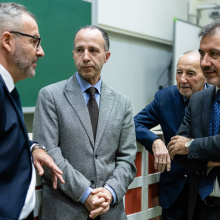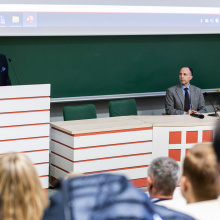Italy is one of the most culturally rich countries in the world. From the Etruscan civilisation to the works of modern artists, Italian museums and monuments are one of the country's main tourist attractions. These items are also of great interest to criminals, which is why a special Carabinieri Unit for the Protection of Cultural Heritage (Italian: Il Comando Carabinieri Tutela Patrimonio Culturale) was set up in 1969. We talk to Carabinieri Brigadier General Roberto Riccardi about what they are defending and why criminals sometimes help them.
You can read the stories of pursuing criminals around the world in the General's book 'Detective dell'arte. Carabinieri on guarding cultural heritage', published by the UG Publishing House.
On November 7, 2022, the University of Gdańsk's Faculty of Law and Administration hosted the promotion of this book, which attracted more than 150 people; there were no free seats in the auditorium and students were even seated on the stairs. The event was attended by the Rector of the UG, prof. dr hab. Piotr Stepnowski, the Deans, dr hab. Wojciech Zalewski, prof. UG and dr hab. Arkadiusz Janicki, prof. UG. A discussion followed the General's lecture. We invite you to read the conversation with the guest of the University of Gdańsk.
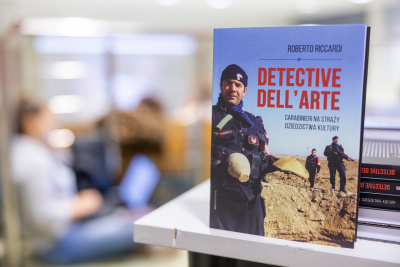
Marcel Jakubowski: - W książce opisuje Pan bardzo szeroki zestaw umiejętności, który muszą mieć Carabinieri ds. Ochrony Dziedzictwa Kultury. Która z tych cech jest najważniejsza?
Gen. Roberto Riccardi: - Pasja. Jako Carabinieri musisz kochać, to co robisz, ponieważ to nie jest zwykła praca. Ta służba wiąże się z budowaniem kulturalnej tożsamości, ochroną wspólnego dziedzictwa. To nie kwestia ekonomii, tylko duszy i piękna. Jednocześnie do rozwiązywania tego typu spraw trzeba być bardzo dobrze przygotowanym. Musisz znać historię sztuki, archeologię i wiele innych dziedzin związanych z kulturą. Przestępcy z tego świata są często ekspertami. To nie przeciętni mafiozi, którzy zajmują się wymuszeniami. Oni znają bardzo dobrze starożytne cywilizacje. Umieją odróżnić przedmioty stworzone przez Etrusków od tych stworzonych przez starożytnych Rzymian i ustalić ich wiek. Carabinieri muszą im tą wiedzą dorównywać i mieć duże doświadczenie. Kandydaci do naszej jednostki przechodzą specjalne szkolenia w ramach włoskiego Ministerstwa Kultury.
- Przestępcy w historiach opisanych w „Detective dell’arte” są nie tylko bardzo kompetentni, ale też zdradzieccy i egoistyczni. Jeden z nich odrywa rękę z rzeźby, inny wydaje swoich kolegów. Co sprawia, że ci ludzie popełniają takie czyny? Czy w nich też jest jakaś pasja do sztuki, czy chodzi tylko o zysk?
- Oscar Wilde powiedział kiedyś, że istnieją dwa występki przeciwko sztuce. Po pierwsze, w ogóle jej nie kochać i po drugie, kochać ją irracjonalnie. Przestępcy, z którymi walczymy, stanowią przykład tej drugiej grupy. Oni często szczerze kochają sztukę, chcą, aby arcydzieło zostało z nimi, ponieważ tylko ich oczy są godne oglądać coś tak pięknego. Płacą złodziejom, aby ukradli dla nich dany obraz czy rzeźbę. Są przy tym bardzo trudnymi przeciwnikami.
- Na początku swojej książki wspomina Pan film „Obrońcy skarbów” (The Monuments Men, 2014) w reżyserii George’a Clooneya. Natomiast mi historie o Carabinieri przywiodły na myśl „Złap mnie, jeśli potrafisz” (Catch Me If You Can, 2002) Stevena Spielberga. W historii opisanej w pierwszym rozdziale Pana książki, czytamy o zabytku, który z Włoch trafił aż do Nowego Jorku. Jak Pana jednostka radzi sobie z tym, że skradzione dzieła mogą być wszędzie?
- Często wykorzystujemy złodziei sztuki w śledztwie. Oni są gotowi nam pomóc, ponieważ mają podwójną naturę. Z jednej strony pożadają dzieł sztuki, z drugiej – chcą ich bronić. Trudno to wyjaśnić. Kiedy się z nami spotykają i zdają sobie sprawę, że planujemy odrestaurować i ochronić dany obraz, decydują się nam pomóc. Jest to dziwne. Taka współpraca oczywiście oznacza też dla nich zmniejszony wyrok. Jednak robią to dlatego, że są pasjonatami sztuki.
- Wcześniej zajmował się Pan zwalczaniem mafii i przestępstw narkotykowych. Jak wyglądało przejście z tej
Marcel Jakubowski: - In your book, you describe a very broad set of skills that Cultural Heritage Protection Carabinieri must have. Which of these qualities is the most important?
Gen. Roberto Riccardi: - Passion. As a Carabinieri you have to love what you do because it is not just a job. This service involves building cultural identity and protecting a common heritage. It's not a question of economics, but of soul and beauty. At the same time, you have to be very well prepared to deal with these kinds of issues. You need to know art history, archaeology and many other fields related to culture. The criminals of this world are often experts. They are not your average mafiosi who deal with extortion. They know ancient civilisations very well. They can distinguish between objects created by the Etruscans and those created by the ancient Romans and determine their age. Carabinieri must match them with this knowledge and have a great deal of experience. Candidates for our unit undergo special training within the Italian Ministry of Culture.
- The criminals in the stories described in 'Detective dell'arte' are not only highly competent but also treacherous and selfish. One of them rips a hand off a sculpture and another hands over his colleagues. What makes these people commit such acts? Is there some passion for art in them too, or is it just about profit?
- Oscar Wilde once said that there are two transgressions against art. Firstly, not to love it at all and secondly, to love it irrationally. The criminals we are fighting are an example of the latter group. They often sincerely love art, they want the masterpiece to stay with them because only their eyes are worthy of seeing something so beautiful. They pay thieves to steal a particular painting or sculpture for them. In doing so, they are very difficult opponents.
- At the beginning of your book, you mention the film The Monuments Men, 2014 , directed by George Clooney. To me, on the other hand, the Carabinieri stories brought to mind Steven Spielberg's Catch Me If You Can, 2002. In the story described in the first chapter of your book, we read about a monument that made its way from Italy all the way to New York. How does your unit deal with the fact that stolen works can be anywhere?
- We often use art thieves in the investigation. They are willing to help us because they have a dual nature. On the one hand, they covet works of art and on the other, they want to defend them. This is difficult to explain. When they meet us and realise that we are planning to restore and protect a painting, they decide to help us. This is strange. Such cooperation obviously also means a reduced sentence for them. However, they do it because they are passionate about art.
- Previously, you were involved in combating the Mafia and drug crime. What was the transition from this job to the Cultural Heritage Protection Carabinieri like?
- At the beginning of my career, I wanted to be on the frontline of the fight against organised crime, in the places where it had developed the most, namely Palermo or Calabria. At the same time, my passion for art developed. I love paintings, sculptures and I also write books myself. The proposal to join the Carabinieri for the Protection of Cultural Heritage came at a very opportune moment. I was then more mature and ready to take a new path. I felt lucky to be the commander of such a unique unit. Despite many differences, both my jobs had the same base. You had to know the behaviour of criminals and carry out undercover investigative operations. As a new commander, I brought with me a lot of experience in combating drug smuggling, which in many ways is similar to art smuggling. When an illegal item appears on the black market, for example, you can conduct an undercover operation in which a law enforcement officer poses as a potential buyer. However, in the case of art smuggling, you have to be credible in this role, knowledgeable about painters and history, in order to enter this world at all.
- Were you surprised by the interest of a Polish publisher in a book that is so immersed in Italian culture?
- Although 'Detective dell'arte' is a very Italian book, I believe that the stories described in it are universal. The Polish translation of the book became possible thanks to prof. Kamil Zeidler, whom I met in Rome. He was interested in what I was writing, in particular precisely 'Detective dell'arte'. I was not surprised when I later officially received the proposal, as I was already aware of his intentions.
do Carabinieri ds. Ochrony Dziedzictwa Kultury?
- Na początku mojej kariery chciałem być na froncie walki z zorganizowaną przestępczością, w miejscach, gdzie ona rozwinęła się najbardziej, czyli w Palermo czy w Kalabrii. W tym samym czasie rozwijała się moja pasja do sztuki. Kocham obrazy, rzeźby, sam też piszę książki. Propozycja, aby dołączyć do Carabinieri ds. Ochrony Dziedzictwa Kultury, pojawiła się w bardzo odpowiednim momencie. Byłem wtedy bardziej dojrzały i gotowy do obrania nowej ścieżki. Czułem się szczęśliwy jako dowódca tak wyjątkowej jednostki. Pomimo wielu różnic, obie moje prace miały tę samą bazę. Trzeba było znać zachowania przestępców i przeprowadzać tajne operacje dochodzeniowe. Jako nowy dowódca przyniosłem z sobą dużo doświadczeń związanych ze zwalczaniem przemytu narkotyków, który pod wieloma względami jest podobny do przemytu sztuki. Gdy nielegalny przedmiot pojawia się na czarnym rynku, można na przykład przeprowadzić tajną operację, w której stróż prawa podaje się za potencjalnego kupca. Jednak w przypadku przemytu sztuki trzeba być w tej roli wiarygodnym, znać się na malarzach i historii, aby w ogóle wejść do tego świata.
- Zaskoczyło Pana zainteresowanie polskiego wydawnictwa książką, która jest tak bardzo zanurzona we włoskiej kulturze?
- Choć „Detective dell’arte” jest bardzo włoską pozycją, to uważam, że historie w niej opisane są uniwersalne. Polski przekład książki stał się możliwy dzięki prof. Kamilowi Zeidlerowi, którego spotkałem w Rzymie. Zainteresowało go to, co piszę, w szczególności właśnie 'Detective dell’arte'. Nie byłem zaskoczony, gdy potem oficjalnie otrzymałem tę propozycję, ponieważ już wcześniej wiedziałem o jego zamiarach.
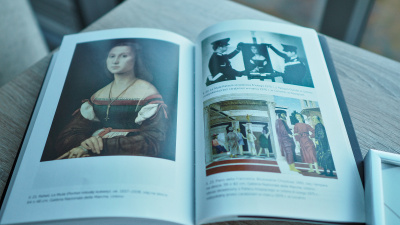
- The Polish edition of the book is 40 pages longer than the original. These pages include photographs of the Carabinieri's activities and the artworks in question. What do you think of this addition?
- It is a good supplement. The UG publishing house and its editor-in-chief Joanna Kamien have done a very good job in adapting the book for a Polish audience. Among other things, there are also footnotes that bring the reader closer to the references to Italian culture and supplement the information on the works of art I have described.
- When introducing artists in your book, you do not usually focus on the positive aspects of their biographies. In the case of Caravaggio, we learn about his escape from the law, and in the case of Raphael, about his tragic death. Why did you decide to describe these events?
- All artists have their dark side. We may think that art is good and art thieves are evil. However, people are much more complicated than that. Art adds beauty to our world, but it draws on all the emotions we have in our arsenal - not only love and friendship but also anger, jealousy or greed.
- 'Detective dell'arte' in its Italian edition was published three years ago. Have there been any crimes and successes of the Carabinieri for the Protection of Cultural Heritage since then that have made you consider writing a sequel?
- For now, I am writing books on other subjects. For example, a biography of Ludwik Guttman, a Polish Jew who fled from the Nazis to the UK, was published in 2021. As a doctor, he treated wounded soldiers and, to get them back into shape, organised sports competitions for them. People in wheelchairs or on crutches took part. In 1960, he organised the world's first Paralympic Games.
- Finally, how does the Carabinieri cooperate with the Polish Police in combating crime against monuments?
- The Polish Police have always been able to count on our kind support, and we are happy to share more than 50 years of experience in operational work in this field. Unfortunately, the task forces previously operating in Poland were disbanded a few years ago and a specialised unit, such as those operating in other countries with a rich cultural heritage, is missing. I hope that this will also change over time.
- Thank you for the interview.
At the invitation of the Faculty of Law and Administration of the Jagiellonian University and Villa Decius, Roberto Riccardi also visited Cracow.
Photo report from the meeting with Gen. Roberto Riccardi at the Faculty of Law and Administration of the Jagiellonian University. Phots by Tomasz Nowicki

